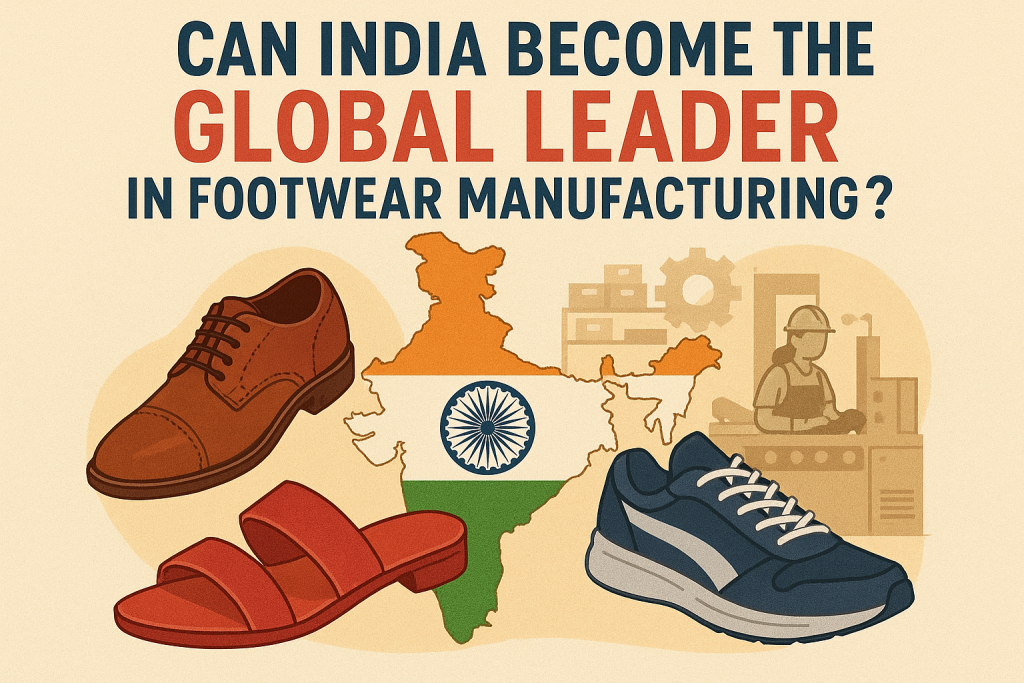Introduction
India has rapidly ascended as one of the world’s foremost footwear producers, currently ranking second only to China and accounting for approximately 13% of global footwear production.However, the question remains: Can India challenge for the top position and truly become the global leader in footwear manufacturing?
India’s Footwear Industry: Current Status
- Production Capacity: India produces nearly 3 billion pairs of footwear annually and employs over 4 million workers in the sector.
- Export Performance: In FY25, exports of leather and non-leather footwear surged by 25% to reach $5.7 billion, with forecasts of surpassing $6.5 billion in the next fiscal year.
- Global Standing: Although the country is the second largest manufacturer, it accounts for only 2.2% of global footwear exports, compared to China’s overwhelming dominance.
Key Drivers for India’s Ascent
1. Government Initiatives & Policy Support
- 100% Foreign Direct Investment (FDI): The sector is fully open to FDI, attracting major players like Hong Fu and Pou Chen from Taiwan, as well as collaborations with Chinese investors, raising industry standards and bringing advanced technology.
- Quality & Standards: Recent BIS quality orders help boost product quality, making Indian shoes more competitive internationally.
- Footwear Mega Clusters: Government-backed clusters and dedicated footwear zones promote economies of scale and efficient supply chains.
2. Innovation & Diversification
- Eco-Friendly and Premium Segments: Brands are focusing on sustainable materials, innovative designs, and athleisure categories, addressing the surge in demand for premium, fashionable, and comfortable footwear.
- Technology Adoption: Indian manufacturers are investing in automation, advanced materials, and digital sales channels.
3. Export Growth & Market Opportunities
- Expanding Export Destinations: USA, Germany, UK, and UAE remain top buyers, and digital B2B platforms further drive global reach.
- Wider Product Range: India excels in both traditional and modern footwear, appealing to diverse markets.
4. Cost Competitiveness
- Affordable Labor & Resources: India’s cost structure remains attractive for overseas investments and large-scale production.
- Resource Availability: The country has access to abundant raw materials, especially in the leather industry.
Challenges on the Path to Leadership
- Fragmented Industry: Approximately 70% of Indian footwear production remains unorganized, causing issues with quality control and scalability.
- Competition from China: China retains higher productivity, better infrastructure, and a larger share of export-oriented factories.
- Counterfeit & Unbranded Products: Rampant counterfeiting and lack of strong domestic brands limit India’s global brand presence.
- Supply Chain Bottlenecks: Fluctuating raw material prices, outdated stock handling, and complex regulatory frameworks hinder smooth operations.
Opportunities for Growth
| Opportunity | Description |
|---|---|
| Technological Modernization | Automation, robotics, and digitization to boost productivity and quality |
| Branding & Global Presence | Building Indian global brands and focusing on premiumization |
| Sustainable Manufacturing | Investing in eco-friendly, vegan, and recycled materials |
| Skill Upgradation | Continued investment in workforce training and design education |
| Strategic Trade Agreements | Leveraging bilateral trade deals to reduce tariffs in key markets |
Conclusion
India is on the cusp of transforming from a volume-driven manufacturer to a global leader in footwear manufacturing. With continued policy support, strategic investments, focus on premium and eco-friendly products, and mastering digital supply chains, India has the potential to not just rival, but possibly surpass, traditional giants in the footwear industry. Realizing this vision will require overcoming structural challenges, boosting branded exports, and sustained innovation across the value chain.



